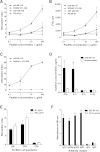A novel murine model of chronic prostatitis/chronic pelvic pain syndrome (CP/CPPS) induced by immunization with a spermine binding protein (p25) peptide
- PMID: 23344231
- PMCID: PMC3602823
- DOI: 10.1152/ajpregu.00147.2012
A novel murine model of chronic prostatitis/chronic pelvic pain syndrome (CP/CPPS) induced by immunization with a spermine binding protein (p25) peptide
Abstract
The pathophysiology of chronic prostatitis/chronic pelvic pain syndrome (CP/CPPS) is poorly understood. Inflammatory and autoimmune mechanisms may play a role. We developed a murine model of experimental autoimmune prostatitis (EAP) that mimics the human phenotype of CP/CPPS. Eight-week-old mice were immunized subcutaneously with prostate-specific peptides in an emulsion of complete Freund's adjuvant. Mice were euthanized 10 days after immunization, and lymph node cells were isolated and assessed for recall proliferation to each peptide. P25 99-118 was the most immunogenic peptide. T-cell and B-cell immunity and serum levels of C-reactive protein and nitrate/nitrite levels were evaluated over a 9-wk period. Morphometric studies of prostate, 24-h micturition frequencies, and urine volume per void were evaluated. Tactile referred hyperalgesia was measured using von Frey filaments to the pelvic region. The unpaired Student's t-test was used to analyze differences between EAP and control groups. Prostates from p25 99-118-immunized mice demonstrated elevated gene expression levels of TNF-α, IL-17A, IFN-γ, and IL-1β, not observed in control mice. Compared with controls, p25 99-118-immunized mice had significantly higher micturition frequency and decreased urine output per void, and they demonstrated elevated pelvic pain response. p25 99-118 immunization of male SWXJ mice induced prostate-specific autoimmunity characterized by prostate-confined inflammation, increased micturition frequency, and pelvic pain. This autoimmune prostatitis model provides a useful tool for exploring the pathophysiology and new treatments.
Figures





Similar articles
-
Experimental autoimmune prostatitis: different antigens induction and antigen-specific therapy.Int Urol Nephrol. 2021 Apr;53(4):607-618. doi: 10.1007/s11255-020-02703-8. Epub 2020 Nov 16. Int Urol Nephrol. 2021. PMID: 33200334 Review.
-
Effect of alcohol on chronic pelvic pain and prostatic inflammation in a mouse model of experimental autoimmune prostatitis.Prostate. 2019 Sep;79(12):1439-1449. doi: 10.1002/pros.23866. Epub 2019 Jun 24. Prostate. 2019. PMID: 31233226
-
Chronic Pelvic Pain Development and Prostate Inflammation in Strains of Mice With Different Susceptibility to Experimental Autoimmune Prostatitis.Prostate. 2017 Jan;77(1):94-104. doi: 10.1002/pros.23252. Epub 2016 Oct 4. Prostate. 2017. PMID: 27699823
-
TRPV1 in experimental autoimmune prostatitis.Prostate. 2020 Jan;80(1):28-37. doi: 10.1002/pros.23913. Epub 2019 Oct 1. Prostate. 2020. PMID: 31573117 Free PMC article.
-
Immunological alterations in patients with chronic prostatitis/chronic pelvic pain syndrome and experimental autoimmune prostatitis model: A systematic review and meta-analysis.Cytokine. 2021 May;141:155440. doi: 10.1016/j.cyto.2021.155440. Epub 2021 Feb 4. Cytokine. 2021. PMID: 33550164
Cited by
-
Trends in experimental autoimmune prostatitis: insights into pathogenesis, therapeutic strategies, and redefinition.Am J Clin Exp Urol. 2024 Apr 15;12(2):52-63. doi: 10.62347/OUJJ3710. eCollection 2024. Am J Clin Exp Urol. 2024. PMID: 38736617 Free PMC article. Review.
-
Tryptase-PAR2 axis in experimental autoimmune prostatitis, a model for chronic pelvic pain syndrome.Pain. 2014 Jul;155(7):1328-1338. doi: 10.1016/j.pain.2014.04.009. Epub 2014 Apr 13. Pain. 2014. PMID: 24726923 Free PMC article.
-
Targeting CXCL12/CXCR4 Signaling with AMD3100 Might Selectively Suppress CXCR4+ T-Cell Chemotaxis Leading to the Alleviation of Chronic Prostatitis.J Inflamm Res. 2022 Apr 21;15:2551-2566. doi: 10.2147/JIR.S352336. eCollection 2022. J Inflamm Res. 2022. PMID: 35479835 Free PMC article.
-
Experimental autoimmune prostatitis: different antigens induction and antigen-specific therapy.Int Urol Nephrol. 2021 Apr;53(4):607-618. doi: 10.1007/s11255-020-02703-8. Epub 2020 Nov 16. Int Urol Nephrol. 2021. PMID: 33200334 Review.
-
The role of inflammatory cytokines and ERK1/2 signaling in chronic prostatitis/chronic pelvic pain syndrome with related mental health disorders.Sci Rep. 2016 Jun 23;6:28608. doi: 10.1038/srep28608. Sci Rep. 2016. PMID: 27334333 Free PMC article. Clinical Trial.
References
-
- Altuntas CZ, Johnson JM, Tuohy VK. Autoimmune targeted disruption of the pituitary-ovarian axis causes premature ovarian failure. J Immunol 177: 1988–1996, 2006 - PubMed
-
- Altuntas CZ, Johnson JM, Tuohy VK. Autoimmune targeted disruption of the pituitary-ovarian axis causes premature ovarian failure. J Immunol 177: 1988–1996, 2006 - PubMed
-
- Arisan ED, Arisan S, Kiremit MC, Unsal NP. Antioxidant enzyme profile in chronic pelvic pain syndrome patients. Advances Mol Biol 1: 41–46, 2007
Publication types
MeSH terms
Substances
Grants and funding
LinkOut - more resources
Full Text Sources
Other Literature Sources
Medical
Research Materials
Miscellaneous

